[English] 日本語
 Yorodumi
Yorodumi- PDB-3q1i: Polo-like kinase I Polo-box domain in complex with FMPPPMSpSM pho... -
+ Open data
Open data
- Basic information
Basic information
| Entry | Database: PDB / ID: 3q1i | ||||||
|---|---|---|---|---|---|---|---|
| Title | Polo-like kinase I Polo-box domain in complex with FMPPPMSpSM phosphopeptide from TCERG1 | ||||||
 Components Components |
| ||||||
 Keywords Keywords | TRANSFERASE / KINASE / PEPTIDE BINDING PROTEIN / Plk1 | ||||||
| Function / homology |  Function and homology information Function and homology informationMitotic Telophase/Cytokinesis / regulation of protein localization to cell cortex / Mitotic Metaphase/Anaphase Transition / synaptonemal complex disassembly / Activation of NIMA Kinases NEK9, NEK6, NEK7 / polo kinase / mitotic nuclear membrane disassembly / homologous chromosome segregation / protein localization to nuclear envelope / Phosphorylation of Emi1 ...Mitotic Telophase/Cytokinesis / regulation of protein localization to cell cortex / Mitotic Metaphase/Anaphase Transition / synaptonemal complex disassembly / Activation of NIMA Kinases NEK9, NEK6, NEK7 / polo kinase / mitotic nuclear membrane disassembly / homologous chromosome segregation / protein localization to nuclear envelope / Phosphorylation of Emi1 / metaphase/anaphase transition of mitotic cell cycle / female meiosis chromosome segregation / nuclear membrane disassembly / synaptonemal complex / Phosphorylation of the APC/C / anaphase-promoting complex binding / Golgi inheritance / outer kinetochore / positive regulation of ubiquitin protein ligase activity / microtubule bundle formation / double-strand break repair via alternative nonhomologous end joining / mitotic chromosome condensation / transcription elongation factor activity / Polo-like kinase mediated events / Golgi Cisternae Pericentriolar Stack Reorganization / regulation of mitotic spindle assembly / RNA polymerase binding / centrosome cycle / positive regulation of ubiquitin-protein transferase activity / regulation of mitotic metaphase/anaphase transition / ubiquitin-like protein conjugating enzyme binding / regulation of mitotic cell cycle phase transition / sister chromatid cohesion / mitotic spindle assembly checkpoint signaling / mitotic spindle pole / spindle midzone / mitotic G2 DNA damage checkpoint signaling / regulation of anaphase-promoting complex-dependent catabolic process / establishment of mitotic spindle orientation / mitotic sister chromatid segregation / mitotic cytokinesis / positive regulation of proteolysis / negative regulation of transcription elongation by RNA polymerase II / negative regulation of double-strand break repair via homologous recombination / Regulation of MITF-M-dependent genes involved in cell cycle and proliferation / Cyclin A/B1/B2 associated events during G2/M transition / protein localization to chromatin / Amplification of signal from unattached kinetochores via a MAD2 inhibitory signal / Mitotic Prometaphase / EML4 and NUDC in mitotic spindle formation / Loss of Nlp from mitotic centrosomes / Loss of proteins required for interphase microtubule organization from the centrosome / centriole / Recruitment of mitotic centrosome proteins and complexes / mRNA Splicing - Major Pathway / Recruitment of NuMA to mitotic centrosomes / Anchoring of the basal body to the plasma membrane / RNA splicing / regulation of mitotic cell cycle / Resolution of Sister Chromatid Cohesion / AURKA Activation by TPX2 / Condensation of Prophase Chromosomes / mitotic spindle organization / regulation of cytokinesis / transcription coregulator activity / establishment of protein localization / positive regulation of transcription elongation by RNA polymerase II / RHO GTPases Activate Formins / APC/C:Cdh1 mediated degradation of Cdc20 and other APC/C:Cdh1 targeted proteins in late mitosis/early G1 / peptidyl-serine phosphorylation / protein destabilization / kinetochore / positive regulation of protein localization to nucleus / centriolar satellite / G2/M transition of mitotic cell cycle / spindle / mRNA processing / spindle pole / The role of GTSE1 in G2/M progression after G2 checkpoint / Separation of Sister Chromatids / transcription corepressor activity / Regulation of PLK1 Activity at G2/M Transition / positive regulation of proteasomal ubiquitin-dependent protein catabolic process / double-strand break repair / mitotic cell cycle / microtubule cytoskeleton / midbody / microtubule binding / RNA polymerase II-specific DNA-binding transcription factor binding / transcription coactivator activity / protein phosphorylation / protein kinase activity / regulation of cell cycle / nuclear speck / protein ubiquitination / protein serine kinase activity / protein serine/threonine kinase activity / centrosome / protein kinase binding / negative regulation of apoptotic process Similarity search - Function | ||||||
| Biological species |  Homo sapiens (human) Homo sapiens (human) | ||||||
| Method |  X-RAY DIFFRACTION / X-RAY DIFFRACTION /  SYNCHROTRON / SYNCHROTRON /  MOLECULAR REPLACEMENT / Resolution: 1.4 Å MOLECULAR REPLACEMENT / Resolution: 1.4 Å | ||||||
 Authors Authors | Sledz, P. / Hyvonen, M. / Abell, C. | ||||||
 Citation Citation |  Journal: Angew.Chem.Int.Ed.Engl. / Year: 2011 Journal: Angew.Chem.Int.Ed.Engl. / Year: 2011Title: From crystal packing to molecular recognition: prediction and discovery of a binding site on the surface of polo-like kinase 1 Authors: Sledz, P. / Stubbs, C.J. / Lang, S. / Yang, Y.Q. / McKenzie, G.J. / Venkitaraman, A.R. / Hyvonen, M. / Abell, C. | ||||||
| History |
|
- Structure visualization
Structure visualization
| Structure viewer | Molecule:  Molmil Molmil Jmol/JSmol Jmol/JSmol |
|---|
- Downloads & links
Downloads & links
- Download
Download
| PDBx/mmCIF format |  3q1i.cif.gz 3q1i.cif.gz | 99.9 KB | Display |  PDBx/mmCIF format PDBx/mmCIF format |
|---|---|---|---|---|
| PDB format |  pdb3q1i.ent.gz pdb3q1i.ent.gz | 74.9 KB | Display |  PDB format PDB format |
| PDBx/mmJSON format |  3q1i.json.gz 3q1i.json.gz | Tree view |  PDBx/mmJSON format PDBx/mmJSON format | |
| Others |  Other downloads Other downloads |
-Validation report
| Summary document |  3q1i_validation.pdf.gz 3q1i_validation.pdf.gz | 464.2 KB | Display |  wwPDB validaton report wwPDB validaton report |
|---|---|---|---|---|
| Full document |  3q1i_full_validation.pdf.gz 3q1i_full_validation.pdf.gz | 464.6 KB | Display | |
| Data in XML |  3q1i_validation.xml.gz 3q1i_validation.xml.gz | 13 KB | Display | |
| Data in CIF |  3q1i_validation.cif.gz 3q1i_validation.cif.gz | 18.3 KB | Display | |
| Arichive directory |  https://data.pdbj.org/pub/pdb/validation_reports/q1/3q1i https://data.pdbj.org/pub/pdb/validation_reports/q1/3q1i ftp://data.pdbj.org/pub/pdb/validation_reports/q1/3q1i ftp://data.pdbj.org/pub/pdb/validation_reports/q1/3q1i | HTTPS FTP |
-Related structure data
| Related structure data |  3p2wC 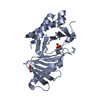 3p2zC  3p34C  3p35C 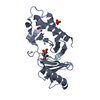 3p36C  3p37C  1umwS S: Starting model for refinement C: citing same article ( |
|---|---|
| Similar structure data |
- Links
Links
- Assembly
Assembly
| Deposited unit | 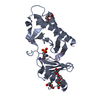
| ||||||||
|---|---|---|---|---|---|---|---|---|---|
| 1 |
| ||||||||
| Unit cell |
|
- Components
Components
-Protein / Protein/peptide , 2 types, 2 molecules AE
| #1: Protein | Mass: 26755.518 Da / Num. of mol.: 1 / Fragment: Polo-box domain, residues 371-594 Source method: isolated from a genetically manipulated source Source: (gene. exp.)  Homo sapiens (human) / Gene: PLK1, PLK / Production host: Homo sapiens (human) / Gene: PLK1, PLK / Production host:  |
|---|---|
| #2: Protein/peptide | Mass: 1128.301 Da / Num. of mol.: 1 / Source method: obtained synthetically / Details: Synthetic phosphopeptide / References: UniProt: O14776 |
-Non-polymers , 4 types, 195 molecules 






| #3: Chemical | ChemComp-1PE / |
|---|---|
| #4: Chemical | ChemComp-PEG / |
| #5: Chemical | ChemComp-PG0 / |
| #6: Water | ChemComp-HOH / |
-Details
| Has protein modification | Y |
|---|
-Experimental details
-Experiment
| Experiment | Method:  X-RAY DIFFRACTION / Number of used crystals: 1 X-RAY DIFFRACTION / Number of used crystals: 1 |
|---|
- Sample preparation
Sample preparation
| Crystal | Density Matthews: 1.85 Å3/Da / Density % sol: 33.64 % |
|---|---|
| Crystal grow | Temperature: 293 K / Method: vapor diffusion, sitting drop / pH: 6.5 Details: 30% PEG400, 0.1M MES, pH 6.5, VAPOR DIFFUSION, SITTING DROP, temperature 293K |
-Data collection
| Diffraction | Mean temperature: 100 K |
|---|---|
| Diffraction source | Source:  SYNCHROTRON / Site: SYNCHROTRON / Site:  SOLEIL SOLEIL  / Beamline: PROXIMA 1 / Wavelength: 0.9184 Å / Beamline: PROXIMA 1 / Wavelength: 0.9184 Å |
| Detector | Date: Nov 17, 2010 |
| Radiation | Protocol: SINGLE WAVELENGTH / Monochromatic (M) / Laue (L): M / Scattering type: x-ray |
| Radiation wavelength | Wavelength: 0.9184 Å / Relative weight: 1 |
| Reflection | Resolution: 1.4→56.54 Å / Num. all: 40284 / Num. obs: 38959 / % possible obs: 97 % |
- Processing
Processing
| Software |
| ||||||||||||||||||||||||||||||||||||||||||||||||||||||||||||||||||||||||||||||||||||||||||||||||||||||||||||||||||||||||||||||||||||||||||||||||||||||||||||||||||||||||||
|---|---|---|---|---|---|---|---|---|---|---|---|---|---|---|---|---|---|---|---|---|---|---|---|---|---|---|---|---|---|---|---|---|---|---|---|---|---|---|---|---|---|---|---|---|---|---|---|---|---|---|---|---|---|---|---|---|---|---|---|---|---|---|---|---|---|---|---|---|---|---|---|---|---|---|---|---|---|---|---|---|---|---|---|---|---|---|---|---|---|---|---|---|---|---|---|---|---|---|---|---|---|---|---|---|---|---|---|---|---|---|---|---|---|---|---|---|---|---|---|---|---|---|---|---|---|---|---|---|---|---|---|---|---|---|---|---|---|---|---|---|---|---|---|---|---|---|---|---|---|---|---|---|---|---|---|---|---|---|---|---|---|---|---|---|---|---|---|---|---|---|---|
| Refinement | Method to determine structure:  MOLECULAR REPLACEMENT MOLECULAR REPLACEMENTStarting model: 1UMW chain A Resolution: 1.4→56.54 Å / Cor.coef. Fo:Fc: 0.959 / Cor.coef. Fo:Fc free: 0.949 / SU B: 1.994 / SU ML: 0.046 / Cross valid method: THROUGHOUT / ESU R: 0.075 / ESU R Free: 0.075 / Stereochemistry target values: MAXIMUM LIKELIHOOD
| ||||||||||||||||||||||||||||||||||||||||||||||||||||||||||||||||||||||||||||||||||||||||||||||||||||||||||||||||||||||||||||||||||||||||||||||||||||||||||||||||||||||||||
| Solvent computation | Ion probe radii: 0.8 Å / Shrinkage radii: 0.8 Å / VDW probe radii: 1.4 Å / Solvent model: MASK | ||||||||||||||||||||||||||||||||||||||||||||||||||||||||||||||||||||||||||||||||||||||||||||||||||||||||||||||||||||||||||||||||||||||||||||||||||||||||||||||||||||||||||
| Displacement parameters | Biso mean: 17.809 Å2
| ||||||||||||||||||||||||||||||||||||||||||||||||||||||||||||||||||||||||||||||||||||||||||||||||||||||||||||||||||||||||||||||||||||||||||||||||||||||||||||||||||||||||||
| Refinement step | Cycle: LAST / Resolution: 1.4→56.54 Å
| ||||||||||||||||||||||||||||||||||||||||||||||||||||||||||||||||||||||||||||||||||||||||||||||||||||||||||||||||||||||||||||||||||||||||||||||||||||||||||||||||||||||||||
| Refine LS restraints |
| ||||||||||||||||||||||||||||||||||||||||||||||||||||||||||||||||||||||||||||||||||||||||||||||||||||||||||||||||||||||||||||||||||||||||||||||||||||||||||||||||||||||||||
| LS refinement shell | Resolution: 1.4→1.436 Å / Total num. of bins used: 20
| ||||||||||||||||||||||||||||||||||||||||||||||||||||||||||||||||||||||||||||||||||||||||||||||||||||||||||||||||||||||||||||||||||||||||||||||||||||||||||||||||||||||||||
| Refinement TLS params. | Method: refined / Origin x: 8.095 Å / Origin y: -0.323 Å / Origin z: 14.42 Å
|
 Movie
Movie Controller
Controller


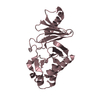








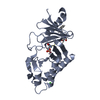
 PDBj
PDBj












